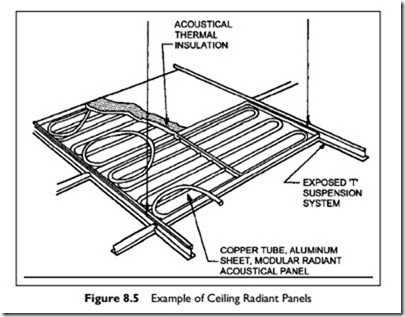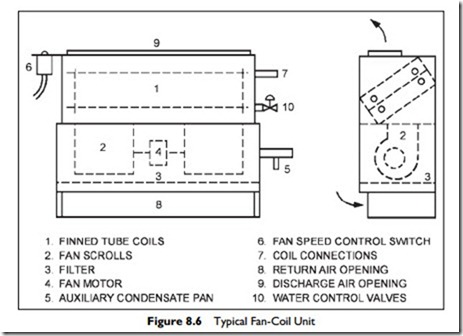Fan Coils
Up to now, the systems we have considered are passive (no moving parts) heating and cooling systems. We will now consider fan coils. As their name suggests, these units consist of a fan and a coil. Fan coils can be used for just heating or for both heating and cooling. In heating-only fan coils, the heating coil usually has fairly widely spaced fins so a lint filter is not critical. In dusty, linty environments, this may necessitate occasional vacuuming of the coil to remove lint buildup. Fan coils can be mounted against the wall at the ceiling. A typical fan-coil unit is illustrated in Figure 8.6.
When the fan-coil is used for heating, the hot water normally runs through the unit continuously. Some heat is emitted by natural convention, even when the fan is “off.” When the thermostat switches the fan “on,” full output is achieved. A thermostat within the unit works well in circulation areas, such as entrances and corridors, where temperature control is not critical, and
temperature differential is large. Generally, in occupied spaces, a room thermostat should be used to control the unit, to provide more accurate control.
Some units are provided with two or three speed controls for the fan, allowing adjustment in output of heat and generated noise. Many designers will choose a unit that is designed to run at middle speed, to minimize the noise
from the unit. Another way to minimize noise from the unit is to mount the unit in the ceiling space in the corridor and duct the air from the unit into the room.
Hot-water fan coils. These are an ideal method of providing heat to the high, sporadic, loads in entrances. In cold climates, if the outside door does not close, the unit can freeze, so it is wise to include a thermostat that prevents the fan from running if the outflow water temperature drops below 120°F. Fan-coils may be run on an outdoor-reset water system, but this limits their output and keeps the fan running more than if a constant, say 180°F, water temperature is supplied to the unit.
Changeover system. The same fan coil can be used for heating or for cooling, but with chilled water instead of hot water. This is called a changeover system. If a coil is used for cooling, it can become wet, due to condensation, and so it requires a condensate drain. The drain requires a slope of 1/8 inch per foot, to ensure that the condensate does not form a stagnant pool in the condensate pan. Failure to provide an adequate slope can result in mold growth and consequent indoor air quality, IAQ, problems. For ceiling-mounted units, providing an adequate slope for the drain can be a real challenge.
If the coil is designed to run dry, with no condensation, then a filter is not absolutely necessary. However, if the coil may run wet, it must be protected with a filter with efficiency minimum efficiency reporting value (MERV) of not less than 6 when rated in accordance with ANSI/ASHRAE Standard 52.2, to minimize lint and dust buildup on the coil. Both the filter and the drain require regular maintenance and therefore access to the unit must be available.
Timing is the challenge of changeover systems: when to change over from heating to cooling and vice versa. For manual changeover systems, the spring and fall can create real headaches for the operator. The system needs to be heating at night but cooling for the afternoon. The question for the operator is “What time should the change occur?” The challenge can be reduced if there is a ventilation system with temperature control. When it is cool outside, the ventilation air is supplied cool, thereby providing some cooling. When it is warm outside, the ventilation air is supplied warm and that will provide a little heating.
Generally, the operator will choose a day and change the system over, so that the spaces are either excessively warm in the afternoon or cool in the morning. The advent of computerized controls has enabled designers to include sophisticated automatic programs that deal with the changeover issue far more effectively than through manual operation.
Four-Pipe system: As an alternative design to a changeover system, the unit can include two coils, heating and cooling, each with its own water circuit. This is called a four-pipe system, since there are a total of four pipes serving the two coils. This system is more expensive to install but it is a more efficient system that completely avoids the problem of timing for change over from heating to cooling.
The four-pipe fan-coil system is ideal for places like hotels, where rooms may be unoccupied for long periods. The temperature can be allowed to drift well above or below the comfort level, since the fan-coil has enough output on full-speed to quickly bring the room to a comfortable temperature. Once the comfortable temperature is achieved, the occupant can turn the unit down to a slower speed so that the temperature is maintained with minimal fan noise.

